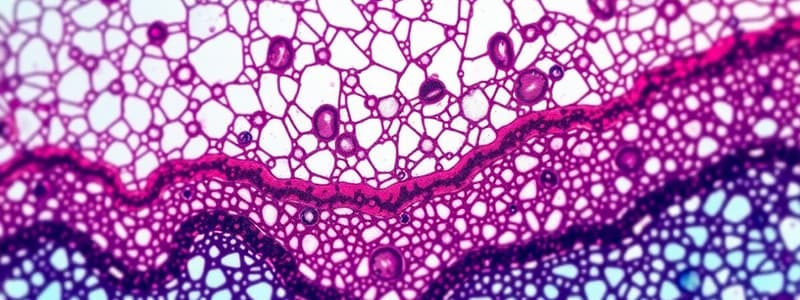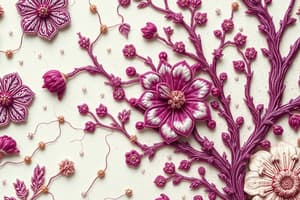Podcast
Questions and Answers
What is the purpose of a vital stain?
What is the purpose of a vital stain?
Which stain is used to visualize mitochondria in living cells outside the body?
Which stain is used to visualize mitochondria in living cells outside the body?
What characterizes a metachromatic stain?
What characterizes a metachromatic stain?
What does histochemical staining primarily identify within cells?
What does histochemical staining primarily identify within cells?
Signup and view all the answers
What type of microscope provides detailed internal views of specimens in black and white?
What type of microscope provides detailed internal views of specimens in black and white?
Signup and view all the answers
What is the primary purpose of 10% formaldehyde in the fixation step?
What is the primary purpose of 10% formaldehyde in the fixation step?
Signup and view all the answers
What is the role of dehydration in the paraffin technique?
What is the role of dehydration in the paraffin technique?
Signup and view all the answers
Which of the following steps involves using a benzene derivative?
Which of the following steps involves using a benzene derivative?
Signup and view all the answers
What is the purpose of embedding in the paraffin technique?
What is the purpose of embedding in the paraffin technique?
Signup and view all the answers
Which staining technique is considered basic?
Which staining technique is considered basic?
Signup and view all the answers
What does 'acidophilic' staining indicate about a tissue?
What does 'acidophilic' staining indicate about a tissue?
Signup and view all the answers
At which stage of the paraffin technique is the tissue cut into 5-8 µm sections?
At which stage of the paraffin technique is the tissue cut into 5-8 µm sections?
Signup and view all the answers
What happens during the impregnation step of the paraffin technique?
What happens during the impregnation step of the paraffin technique?
Signup and view all the answers
Study Notes
Histology - Lecture 1
-
Micro technique: Techniques used to prepare tissue samples for microscopic examination.
-
Paraffin technique: A common technique for preparing tissue for histological examination.
- Advantages: Easy to use and provides good tissue preservation.
- Issues: Paraffin can melt at high temperatures, potentially damaging tissue.
- Frozen technique: Used for rapid tissue preparation.
- Colloidin technique: A technique that employs colloidin, a solution that hardens tissue for sectioning.
-
Paraffin technique: A common technique for preparing tissue for histological examination.
Paraffin Technique: Steps
- Tissue sample: The first step is to obtain a tissue sample. It is important to ensure that the sample is handled carefully and quickly to prevent tissue deterioration.
-
Fixation:
- The most common fixative used in histology is 10% formaldehyde.
-
Purpose:
- It preserves the fine structure of tissues, preventing deterioration.
- It inhibits the activity of lysosomal enzymes, which can cause autolysis (self-destruction of cells).
- It kills bacteria, preventing putrefaction (decomposition).
- It hardens tissues, making them easier to cut.
- Dehydration: Removal of water from the tissue sample using a series of graded alcohols to prevent tissue damage.
- Clearing: The tissue sample is then transferred to a paraffin solvent. Commonly, xylene or other benzene derivatives are used.
- Impregnation: The tissue sample is placed in melted paraffin, which penetrates the tissue, replacing the clearing agent.
- Embedding: The tissue sample is placed in a mold filled with melted paraffin, which solidifies into a block.
- Sectioning: The paraffin block is cut into thin sections using a microtome (5-8 µm thick).
- Mounting: The tissue sections are then mounted on glass slides.
Staining Techniques
-
1) Basic & Acidic Stains:
- Hematoxylin & Eosin (H&E): A common stain used in histology.
- Hematoxylin is a basic dye, while Eosin is an acidic dye. This means Hematoxylin stains basophilic structures, while Eosin stains acidophilic structures.
-
Basophilic: Affinitive to basic stains. These structures include:
- Nucleus (due to DNA & RNA)
- Ribosomes
-
Acidophilic: Affinitive to acidic stains. These structures include:
- Cytoplasm
- Muscle
-
Basophilic: Affinitive to basic stains. These structures include:
- Common Basic Stains: Hematoxylin, Toluidine Blue
- Common Acidic Stains: Eosin, Orange G
-
2) Neutral Stains:
- These stains are made of a combination of a basic dye and an acidic dye.
- They can stain different tissue structures depending on their pH.
- Example: Leishman's Stain
-
3) Vital Stains:
- Staining methods used for living cells inside the living body.
- Example: Trypan blue. This dye is taken up by phagocytic cells, which are responsible for engulfing foreign bodies.
-
4) Supravital Stains:
- Staining of living cells outside the body.
- Example: Janus Green B Stain, which targets mitochondria.
-
5) Metachromatic Stain:
- A certain cell component stains with a color different from the original dye.
- Example: Mast cells stained with Toluidine Blue appear red due to their high protein content. This phenomenon is called a metachromatic reaction.
-
6) Histochemical Stain:
- Used to identify specific chemical structures within cells.
-
Examples:
- PAS Staining: Used to stain glycogen (carbohydrates) in liver cells.
- Sudan III: Used for staining fats.
- Note: Carbohydrates and Lipids are often dissolved during the paraffin technique because of the heating process (50°/60°C).
-
7) Immunohistochemistry:
- Used to identify and localize specific proteins using antibodies.
-
8) Special Stains:
- These are specialized stains used to differentiate between specific cell types or structures.
- Example: Silver stain, which stains the Golgi apparatus brown and in color.
Microscopes
-
Light Microscope:
- Uses a beam of visible light to illuminate the sample.
- Produces colored images.
- Cannot resolve very small structures within cells.
-
Electron Microscope:
- Uses a beam of electrons to illuminate the sample.
- Produces black and white images.
- Provides high resolution, allowing visualization of fine details within cells.
- Transmission Electron Microscopy (TEM): Produces two-dimensional (2D) images.
- Scanning Electron Microscopy (SEM): Produces three-dimensional (3D) images.
Studying That Suits You
Use AI to generate personalized quizzes and flashcards to suit your learning preferences.
Related Documents
Description
Explore the essential micro techniques for histology in this quiz. Focus on different methods such as paraffin, frozen, and colloidin techniques, along with their advantages and challenges. Understand the key steps involved in preparing tissue samples for microscopic examinations.




